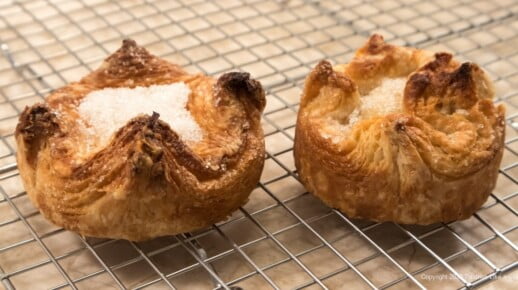
Left: English Muffin ring, Right: 3x2" ring
A Better Kouign Amann revises this pastry for a better outcome. My first post on Kouign Amann was in September, 2016. There you will find the how to photos and a lot more information on this superb pastry.
Recently I was asked to teach a private zoom class and I chose Kouign Amann as my subject. After re-testing, I discovered some very interesting, small changes which make a world of difference that truly set this apart.
Change of Sugar
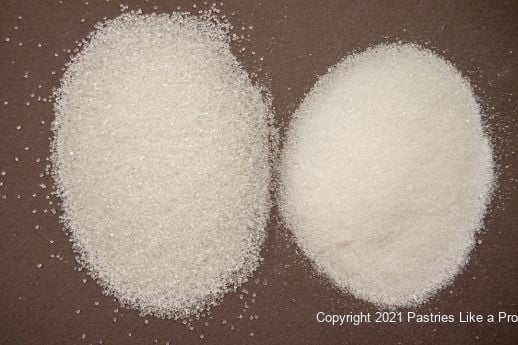
Left: Sanding Sugar, Right: Granulated Sugar
I kept the original recipe since it works just fine. However, I changed the sugar from granulated to sanding sugar. This is a very coarse sugar that is usually used for decoration and to add crunch. It stays crunchy when baked as you can see in the photo. However, it doesn’t liquefy when chilled as quickly as granulated sugar does. It does, under high heat, caramelize on the outside of the pastry which is the point of the sugar, as well as sweetness.
Sanding sugar is more widely available in grocery stores, specialty stores, kitchen stores and on line.
Rising Time
In the first blog, I recommended letting them rise 30 minutes as did other recipes. This time I let them double before baking. Croissant and Danish dough are both allowed to rise until doubled or nearly doubled before baking. They are both laminated dough so why was the rising time for Kouign Amann cut to a mere 30 minutes which is hardly time for them to warm up? The difference is astounding. They become a completely different and more wonderful pastry.
I put my shaped pastries in a cold oven with the light turned on. I monitor the temperature and if it gets above 80°F, I prop the door open with a wooden spoon. 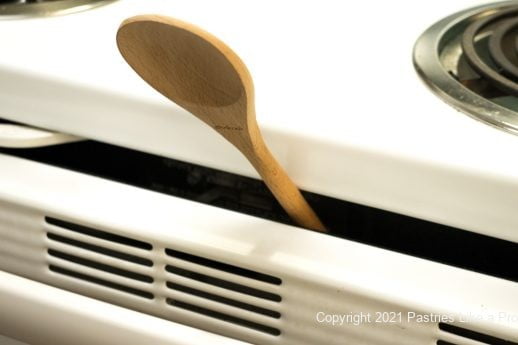
Reduced the number of Pastries
Even with allowing them to double in size before baking, I thought they were too thin. So, I reduced the number from 12 to 10 which improved them tremendously.
I rolled the dough into a 21 x 9 inch rectangle, trimming it to 20 x 8 inches. Cut the 8” side in half making two 4” strips. Cut the strips 5 across the 20” side making 10 - 4” squares. They are shaped exactly the same.
Baking Temperatures for A Better Kouign Amann
I changed the starting baking temperature to 400°F giving the pastry an initial burst of high heat to get it going. After 10 minutes I reduced it to 350°F so it would bake throughout in about 15 to 20 minutes more.
Equipment
The pan in which the pastry is made is important. When I first made this, I went along with everyone else and used a Texas muffin tin in which to shape them. But they remained small and after sitting for a while became almost hard to eat. This time I tested a couple of different ways to mold them.
Ring Molds
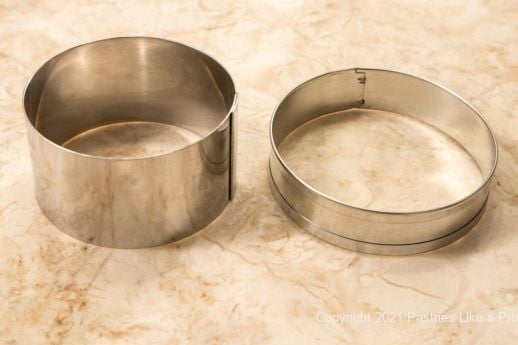
Left: 3x2" ringmold, Right: English Muffin ring mold
As I mentioned in the original article about kouign amann professionals use small ring molds. They have no bottoms – the pan on which they are placed becomes the bottom of the mold. The pastries are shaped and just plopped into the rings where they rise. I used my 3 ½ x 1” English muffin rings, a 3 x2 inch round ring mold and a Texas Muffin cup.
This was one of the most consequential changes I made. The two ring molds, because of they are bigger than Texas muffin cups and the fact they had straight sides and were not tapered as is the muffin mold, did a much better job of baking the pastry all the way through. While the outside was crispy from the caramelized sugar, the interior gave way to a sweet, soft dough.
They looked better and tasted like a whole new pastry - crispy on the outside and soft on the inside with a definite crunch of caramelized sugar. The only downside is they usually don’t retain the top shape. They open up like a flower allowing the pastry to bake throughout without overbaking the outside.. A small difference for a much improved product.
Double Panning is very important when using the rings. It slows the baking to the bottom allowing the interior to get completely baked.
The rings are very easy to remove immediately by using a pair of tongs to just lift them up and away from the pastry. I then use a pancake turner to transfer them to a cooling rack.
Texas Muffin Cups
While the muffin tins can be used, the Kouign Amann are much more compact and have a tendency to become hard upon sitting. Also, since most of the Texas muffin tins I have seen are dark, the exterior of the pastry darkens very quickly almost burning before the inside is done baking.
Make Ahead
I was really happy to realize these can be fully baked and frozen. Simply cool them completely, freeze them, then wrap well and freeze for up to a month. Kouign Amann whenever you want them! Just thaw them at room temperature on a rack. They benefit from a brief heat up in a 350° oven for about 10 to 15 minutes if thawed.
Conclusion for A Better Kouign Amann
Will the recipe work as originally written? Absolutely.
Will the changes make a better Kouign Amann? For sure.
A BETTER KOUIGN AMANN
The proper way to make this pastry is to use salted butter. I talk about this in the stuffed or not kouign amann post. But if all you have is unsalted, that's fine also. While most articles insist on using European Butter such as Plugra or Kerry Gold, I don't. They are extremely soft. If you hold them in your hand, they start to melt.
American butter has a lower butter fat content by about 2 to 3%. The additional water in the butter makes it more solid keeping it from softening too quickly. I do use European butter in other recipes and I love it - but not when laminating.
For how to photos please go check out kouign amann.
Initial Dough (Detrempe)
¾ cup water
2 ¼ teaspoon active dry yeast ( 7 gram package or ¼ ounce)
2 ¼ cups all purpose flour (315 or about 11 ounces)
1 teaspoon salt
2 tablespoons melted butter (1 ounce or 30 grams)
1 cup salted or unsalted butter (225 grams, 8 ounces or 2 sticks)
⅔ cup sanding sugar (130 grams or about 4 ½ ounces)
Processor Method
Combine the water and yeast. Set aside to soften the yeast. Place the flour and salt in the processor. Pulse several times to mix. Add 2 tablespoons melted butter to the water and pour over the flour. Process until the dough balls up. Remove from the processor and knead several times. Place in a bowl that has been sprayed. Turn it over. Cover with film and allow to rise for about an hour or until doubled.
Punch down and flatten. Wrap in film and freeze until frozen about 2 to 3 inches in from the edge. The center should be very cold but not completely frozen.
Butter Enrichment
1 cup unsalted or salted butter (225 grams, 8 ounces, or 2 sticks)
Cut each stick of butter in half lengthwise. Roll the butter one quarter turn and cut lengthwise again. Then cut it into 8 equal pieces. You will have 32 small cubes of butter. Freeze the butter pieces until hard.
When the butter is frozen and the dough is partially frozen, cut the dough into quarters. Cut each quarter into 3 pieces.
Place 4 pieces of dough into the processor. Add one third of the butter and pulse quickly about 20 times until the dough and butter are cut into uneven pieces. Pour it out onto a work area. Repeat two more times with the remaining dough and butter.
Flour the work area lightly. Push the dough and butter into a rectangle about 6" long and 4" wide. Dust the top with flour. Roll about 18 x 6 inches, scraping under the dough to keep it from sticking and flouring lightly as necessary. Keep the ends as square as possible and the sides as straight as possible. Brush any flour off the dough. Fold the top down to the middle and bottom up to the middle. Brush flour off again. Fold the top over the bottom. This is called a book fold.
Turn the dough 90° so the folded edges are to your right and roll again to about 18 x 6 inches, lightly flouring the board and top of the dough as necessary. Brush the flour off and fold as above. Wrap in film and refrigerate for about an hour or up to three days. It can also be frozen at this point. Thaw in the refrigerator overnight before making the final turns.
Once the sugar has been rolled in, the dough should be completed the same day. If you try to hold it, the sugar will liquefy and the dough will become wet.
Final Two Turns
Kouign Amann dough
⅔ cup sanding sugar
For the third and fourth turns, roll the dough out to about 18 x 6 inches. Brush the flour off and sprinkle with ⅓ cup granulated sugar. Place a piece of waxed paper over the sugar and lightly roll it in. Fold the ends to the middle and then fold the top down over the bottom as before. Turn 90°. Repeat once more rolling in the remaining sugar. Fold the dough, wrap in plastic wrap and let it rest in the refrigerator for an hour.
Shaping
Spray 10 English muffing rings or 3 x 2" round rings well. Or Spray ten Texas muffin cups very well. Set aside.
Roll the dough into a 21 x 9 inch rectangle. Trim to 20 x 8 inches. If the dough is soft chill it in the freezer for 15 to 20 minutes. Cut the 8" side into 2 - 4" strips. Cut the 20 inch side every 4" for a total of 10 - 4" squares.
Place a teaspoon of sanding sugar in the middle of a square. Bring all the corners up to the middle. Pinch together. Place inside the rings or the muffin pan.
Cover the molds or muffin tin with a towel and let rise for about 1 ½ hours or until doubled.
Baking – Double Pan if using rings. Preheat the oven to 400°F. If using dark pans, you may want to start at 350°F. Bake for 10 minutes. Lower the temperature to 350°F (or 325°F if using dark pans). It's fine if they become a deep brown on the bottom. Just don't burn them. Remember the sugar is going to caramelize making a very crunchy treat.
Releasing – It is very important to get these out of the muffin cups as soon as they come out of the oven. They will get cemented in the cups if they cool. If using rings, just remove the rings with a pair of tongs. If using muffin tins, go around the pastries with a small metal spatula and turn them out.
These are best eaten the day they are made. I prefer the Kouign Amann completely cooled to room temperature when they are at their most flavorful and at their crunchiest!
I think the revisions used in A Better Kouign Amann will make the finished pastries a better version of this best of all pastries.
Other laminated recipes include: Croissant-Queen of Breads, Pithiviers, Sunny Side Up Apricot Pastries.


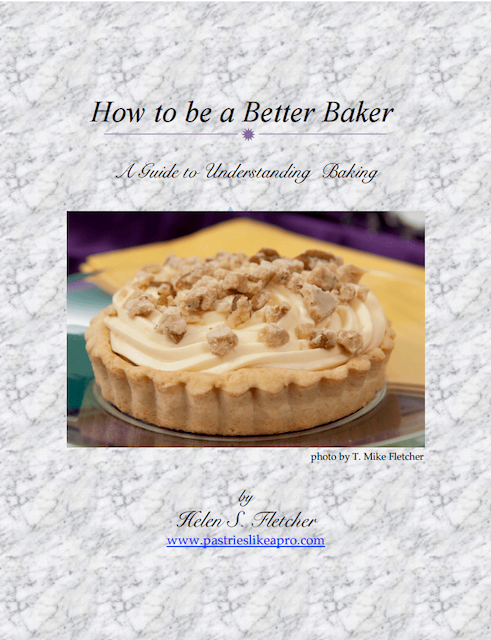
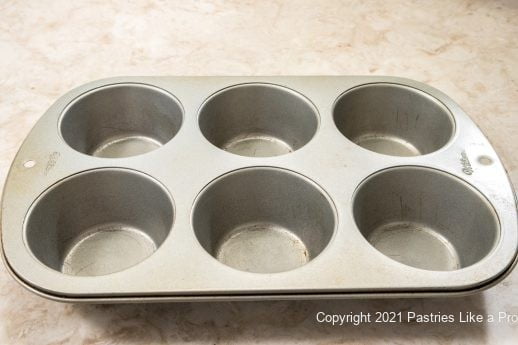
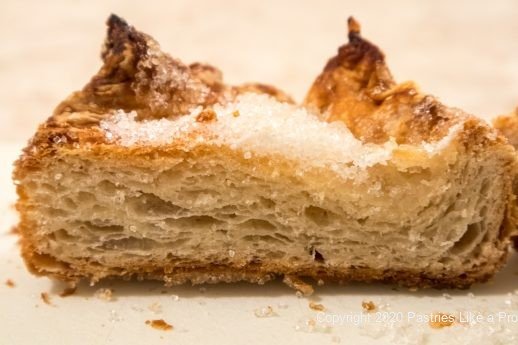


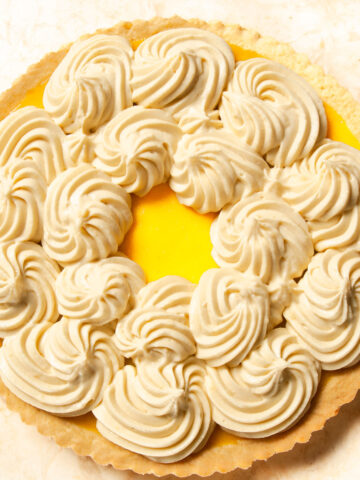
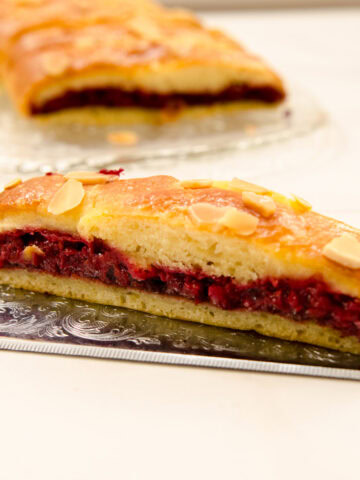
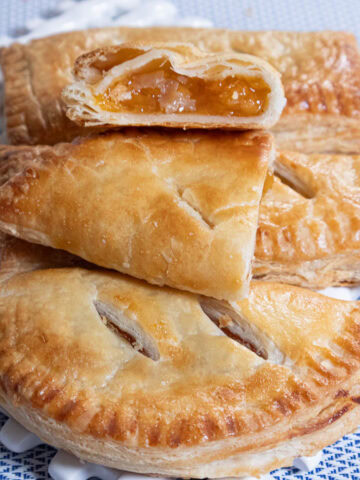
Elaine says
Hi from Malaysia, I made these a few days and they were some of best I’ve managed to produce! Used turbinado sugar as that was what I had on hand- Thank you for the time and guidance. I found the dough very manageable, Could I use this dough for croissants? How would it compare to your croissant pastry? I thank you again in advance
Helen S Fletcher says
Hi Elaine - Thank you so much for this. I have a post on Croissant which is very close to this. Go to Croissant, Queen of Breads in France. I think you will enjoy this also.
Elaine says
Thank you for your quick reply, I will definitely do that then, I’d also like to try your quick danish pastry recipe for danish scrolls
Helen S Fletcher says
You're welcome.
Kristi Felbinger says
Hi! I am having trouble with my Kouign Amann sweating after it’s baked and cooled. The caramelized outside starts to break down. Is there a way to slow that down? I make a cake style Kouign Amann (as opposed to individual size) and maybe that has something to do with it. Will the courser sugar make any difference with that?
Helen S Fletcher says
Hi Kristi, In all the batches I have made or I know about this is unique. What pan or molds are you using for these? Are you removing them as soon as they come from the oven? How long are you baking and at what temperature. Is there a lot of humidity? The only reason I went to the larger sugar was to prevent the granulated sugar from melting and getting watery when these had to go into the fridge or freezer to firm up. That makes no difference. It's hard for me to say since I'm not there. Answer my questions here and I might be able to help more.
Dennis says
Looks like you also switched from Bread flour in your original recipe to All Purpose in this recipe. I recently tried to make this with bread flour but it seemed too bready but I'm not sure if it's a technique issue or if it's the flour.
Helen S Fletcher says
Hi Dennis, What did you use as a form? Muffin pans, baking rings? I think the main problem with homemake Kouign Amann is squashing it together so tightly in muffin tins or forms that are too small. It is difficult for the dough to expand into layers when it is so confined. I will be revisiting this at some point to work on my theory. All of the ones I have seen online look bready on the inside. The technique is solid. I have used it for Croissant as well as Pithiviers. In fact, the Croissant article has been published elsewhere because it works. You can see in the photos for pithiviers from before it was baked to the rise it got after it baked. Whether the butter is rolled in as a block, added in grated or chunked in as I do, they all work if done correctly and the dough is rolled and folded several times. The steam is what pushes the layers apart and up. Stay tuned!
Yuliya says
To prevent your Kouign Amanns from opening too much, you can turn them upside down after shaping and let them sit for a few minutes before placing them into the rings.
Helen S Fletcher says
Thanks for this Yuliya. The information looks interesting.
Jane E Robbins says
Thank you. This excellent post is right in line with what I always associate you with, deep knowledge of European pastry. Glad to have a new use for my tart rings.
hfletcher says
Those rings are the best for Kouign Amann, Jane. Glad you have them.
Carolyn says
This is an excellent post - thank you. I have made Kouign Amann a few times with good results but this should take it to the next level. A couple of questions:
- Would corse sugar work instead of sanding sugar? We’re in full lockdown and obtaining sanding sugar is pretty difficult these days.
- I thought high fat butter was necessary to obtain the flakiness desirable in croissants, Kouign Amann and other laminated pastries? How will using regular butter affect the flakiness of the Kouign Amann?
Thank you!
hfletcher says
Thank you Carolyn - If you are referring to Swedish or Belgium pearl sugar it is too coarse. Just use granulated sugar and keep refrigeration down to the times given. All the Kouign Amann I make is with American butter. I talk about the European butters being very soft and difficult in the roll out stages. I use it elsewhere but not here at least not in the revised recipe. It does great.
Cheryl Matzker says
Helen, You may remember that I have dear friends in Brittany! I was at their house when you emailed me about the sablés bretons. I'd never had kouign amann until they moved to Brittany and I fell in love with them there! I'm looking forward to trying my hand at these!
Thank you!
Anita says
I am about to start making a 2021 baking bucket list and this will for sure make it! Time, I need more time! Thank you, as always, for the wonderfully detailed, well thought out and tested recipes.
hfletcher says
Thank you Anita. I'm with you Time! How fleeting it is.
Barbara says
Thank you for the updated information. These look scrumptious. I am going to try making these pastries. I do not have English Muffin rings, but do have a hamburger bun pan purchased from King Arthur Baking. I use it to make individual pies or tarts when I must make multiples for a gathering. It is a little larger then the muffin rings, 4 inches, but that should not make a big difference. Its only drawback is its a bit darker and not shiny like the rings. I also have a muffin top pan I use for multiple individual galettes, but do not think it is deep enough and it is also darker.
hfletcher says
Hi Barbara - Use the hamburger bun pans and reduce the initial heat to 375°F. Place the pans on another baking sheet to slow down the heat to the bottom. The final time may vary somewhat, just make sure they are baked through.
sallybr says
I cannot find enough adjectives to praise this post... you know, I've made these babies twice and both times I was not fully happy with the results, but oddly enough I could not quite tell why.
reading your post, I think I now know - I did not use any of the adjustments that you proved improve the recipe
I don't usually make laminated dough for us because of excessive saturated fat (hubby issues) but I am going to make these just because I am absolutely mesmerized by your "experiments"
THANK YOU!
hfletcher says
Hi Sally - Thank You!! The funny thing is, I don't think I would have done all of this had I not been teaching the class. It's funny how things work out. This is, by far, a better product. Every time I made these Mike would exclaim about how good they are. Not sure that is as great as it sounds, he says that about everything I make - which is one of the reasons I love him.